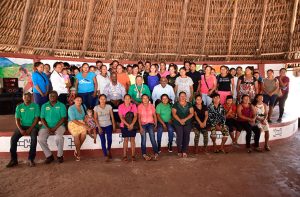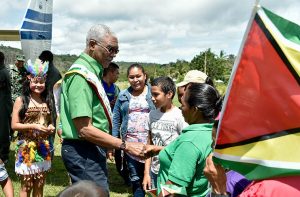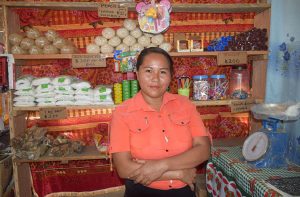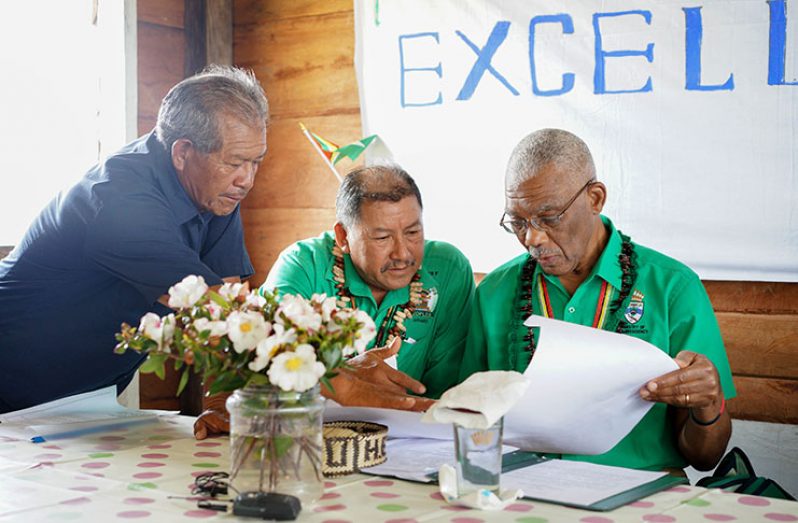– over two thousand businesses created through HEYS
– four new capital towns commissioned
PRESIDENT David Granger is resolute that Guyana’s development will not be limited to the coastland, but will extend to all regions of the country as hinterland development is essential to national development. The President has said that it is imperative that all branches of Government are functional and that hinterland regions are equipped to manage their growth through Local Government. To this end, the President has commissioned four new capital towns in far-flung locations to empower them to become the drivers of growth in their regions.
Achieving township status
The towns namely, Lethem, Upper Takutu-Upper Essequibo (Region Nine); Mabaruma, Barima-Waini (Region One); Bartica, Cuyuni-Mazaruni (Region Seven) and Mahdia, Potaro-Siparuni (Region Eight), are the centres of economic growth and public services.

“You go to any part of Europe, of Asia, the majority of people live in towns. Towns are the hubs of economic development, towns are where the populations concentrate, towns are the hubs of business and industry… The same thing is going to happen in Guyana… you don’t have to leave your region, all you have to do is go to the regional capital to transact all of your business,” President Granger said at the commissioning of the most recent town, Mahdia, on October 25, 2018.
The President said Guyana is now on the path to enhancing the standard of living of all Guyanese by reducing inequalities and decentralising services.
“We’re not going back, we are moving forward with the creation of these townships…We’re now on the road to the integration of these regions, the regions now have a centre, so people from outlying areas can come to that centre” he said.
In keeping with this goal, the Government has spearheaded several programmes aimed at preparing young people in the hinterland to become entrepreneurs. These programmes were among several reflected in the Ten-point Action Plan for hinterland development which the Head of State unveiled at the National Toshaos Council on August 18, 2015.

The Hinterland Employment and Youth Services (HEYS) features prominently in this strategic plan as its overall goal is to help reduce poverty. From January 2016 to July 2019, the Government has invested over $2 billion in the HEYS programme, creating 2,500 small businesses in the hinterland and training over 3,500 youth.
The one-year training programme, which is administered through the Ministry of Indigenous Peoples’ Affairs aims to “provide educational, entrepreneurial, vocational and technical training opportunities that will lead to empowerment, job creation and employment, while improving sustainable livelihoods.” It caters for youths age 16-35.
The Ministry utilises local expertise in the various Indigenous villages to conduct the training, which, in turn, creates jobs for the villagers. During the first six months of the HEYS, young people are taught life skills, vocational studies and academics. The second six-month period is used to create and execute a business plan.
Minister within the Ministry of Indigenous Peoples’ Affairs, Ms. Valerie Garrido-Lowe, said the Government carefully examined the assets of hinterland villages and came up with a plan to transform them into monetary benefits for the residents. The Minister noted that while the hinterland is ripe with opportunities for business development, careful thought must be put into determining how best to capitalise on those prospects.

Minister Garrido-Lowe said that the plan is to empower hinterland residents to go into business by guiding them through the process from beginning to end. She emphasised that this approach teaches them that it is not only about producing raw products but taking those products to the end of the value chain.
“For instance, in Moruca, Santa Rosa, we have coffee. Moruca used to produce coffee years ago when I was a child and after that it went down, but now we’re going into the coffee business. Government has been supporting 15 farmers to grow coffee again. The aim is not only to sell the seeds but we want to add value to it… we want the factory, we want to roast it, we want to ground it, we want to package it, we want to brand it and we want to help get the sales for it,” the Minister said. “That’s only one project, we have more,” she added.
Minister Garrido-Lowe said that the HEYS initiative provides a second chance for hinterland youth who are early school-leavers, unskilled and unemployed.
“You had a lot of youths in the hinterland really needing attention, really needing that extra push, just to lift them up in their lives so that they can continue… It gives them a second chance to uplift their life, to learn skills and to go back in class and improve their English and Maths. Learn about budgeting, learn about business and vocational skills like carpentry, joinery, masonry, garment construction and so on,” she said.
In this regard, she informed that the 2, 500 jobs that were created through the HEYS create more employment when those businesses expand. As such, it may lessen the occurrence of persons travelling from village to village and even as far as to Georgetown seeking employment.

In 2019, through the Ministry of Indigenous Peoples’ Affairs, each existing HEYS business was given an additional stimulus grant of $50,000 to assist with any shortcomings encountered, in an effort to ensure that the businesses are sustainable.
Toshao of Santa Rosa village, Barima-Waini (Region One), Ms. Whanita Phillips, said her village has benefited from HEYS through the establishment of several small businesses. “Some of them are into sewing, they are into craft, they sell food stuff and other things… These youths have really been benefiting from HEYS. They have their little businesses, they are back on track, some of them are [pursuing further] education… and they are doing really well. They are focusing on what they are doing and I’m very thankful to the Government for giving them that opportunity,” she said.
HEYS beneficiary, Ms. Marissa Paulo of Shulinab Village, Upper Takutu-Upper Essequibo (Region Nine) is now an entrepreneur. She sells gasoline and spare parts for motorcycles. For her, the commercial activity fits in well with her fiancé’s business, since he is a mechanic.
“When I started, I started with the grant that they gave to me and I bought motorcycle parts and gasoline … I really wanted a business in my life and I had everything set up already for it and then when I got this little income it was a good start for me,” Ms. Paulo said.
Hinterland development is priority for the Government. Guyana is on the brink of massive economic transformation from the sustainable development of our petroleum sector and the Government has outlined plans that will ensure that the hinterland regions will not be left behind.



.jpg)









